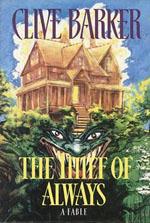The Thief of Always
Clive Barker
Harper Collins Publishers
US Trade Hardcover
ISBN 0-06-017724-I
240 pages; $20.00
Date Reviewed: 10-31-1992
Reviewed by Rick Kleffel © 2002

REFERENCES
COLUMNS
|
|
|
The Thief of AlwaysClive BarkerHarper Collins PublishersUS Trade HardcoverISBN 0-06-017724-I240 pages; $20.00Date Reviewed: 10-31-1992Reviewed by Rick Kleffel © 2002 |
|
|
REFERENCES |
COLUMNS |
Clive Barker's latest novel, "The Thief of Always" will surprise his heretofore adult audience. Known for incorporating graphic elements of sex and violence into his horror-fantasy novels, Barker forgoes his "adult" excesses, and applies his talents to "a fable for all ages", a dark amalgamation of Peter Pan, Pinnochio and the Wizard of Oz. Because it's a fable, it has a moral content, but one that's distinctly modern in tone and light in touch. Most importantly, it's a joy to read, as Barker's clear, poetic prose carries the reader into the world of Harvey Swick, a ten year old boy with a penchant for asking questions.
As the novel begins, Harvey is "imprisioned in the great grey beast February". Like most kids, he's bored, not up for a few chores around the house, and asks only for fun. In short order, he's whisked away to the "Holiday House" by Mr. Rictus, who makes him promise not to ask questions about the house or its mysterious proprietor, Mr. Hood.
For a while, Harvey just accepts the Holiday House for what it seems to be; a luxurious estate where it's sping every morning, summer every day, Halloween Fall every evening and Christmas every night. Despite the strangeness that surrounds him, Harvey is able to call his parents, who tell him that they've arranged for him to have an extended holiday in the "House of Always". Barker brings off this exposition by using his flair for inflicting the imaginary on the mundane.
But when Harvey discovers the shadowed lake behind the house, he begins to doubt his surroundings: "Despite all the entertainments that the Holiday House supplied so eagerly, it was a haunted place, and however he had tried to ignore his doubts and suppress his questions, they could be ignored and suppresed no longer. Whoever, or whatever, that haunter was, Harvey knew he could no longer be content until he'd seen its face and knew its nature." In this manner Barker cleverly weaves the moral of his fable with the nature of the supernatural story.
For when Harvey tries to leave, the modern moral imperative to "Question Authority" becomes a matter of survival. Barker's employs a light but sinister touch throughout the novel. The short chapters will make the book accesible for youger readers, while having the effect of making the book into a page-turner for their parents. The illustrations by the author are, like the prose, evocative without being overly graphic.
This is not to say that the book is without shocking scares. When Mr. Hood is finally revealed, in a primally terrifying scene, even the most jaded horror fan will be impressed. Barker culminates the seasonal themes in this novel with a description of a storm that demonstrates his facility for creating wonders as mesmerizing as his horrors: "It had more than lightning at its dark heart. It had the light rains that came at early morning to coax forth the seeds of another spring; it had the drooping fogs of autumn, and the spiraling snows that had brought so many midnight Christmases...shafts of sunlight pierced the storm-clouds in the name of Summer, only to be smothered by Fall's fogs, while...Spring coaxed its legions out of bough and earth, then saw its buds murdered by Winter's frosts before they could show their colors."
Like the storm he describes, "The Thief of Always" shows that Barker has more than darkness in his heart. There's room enough for whimsy, romance, and a talent that positively terrifying.